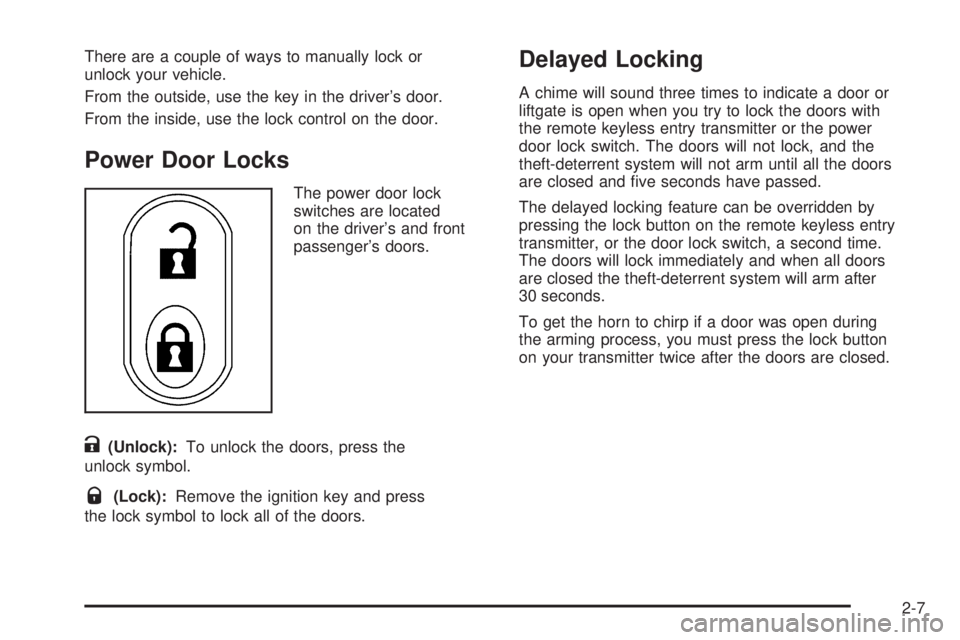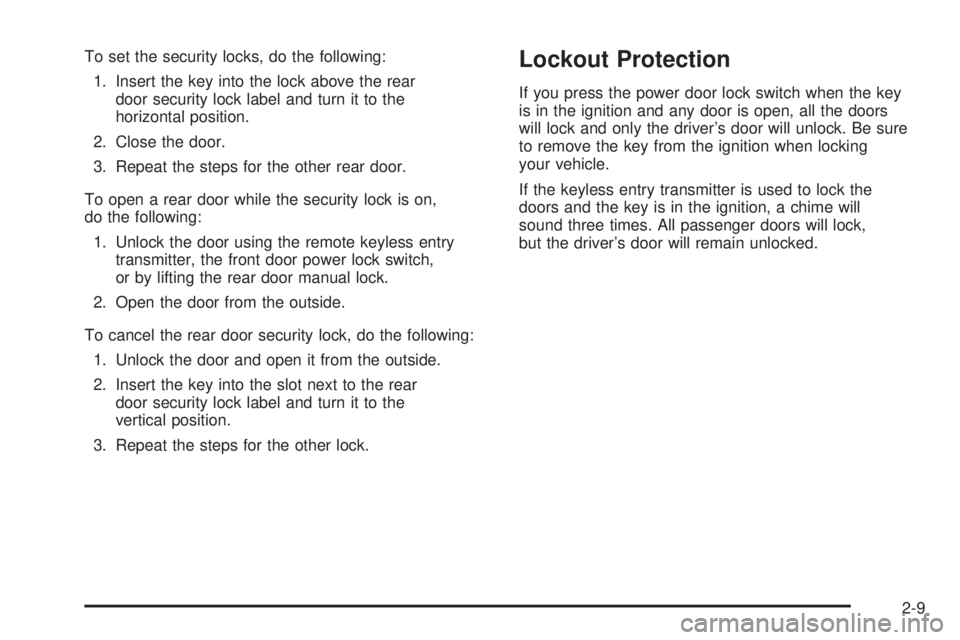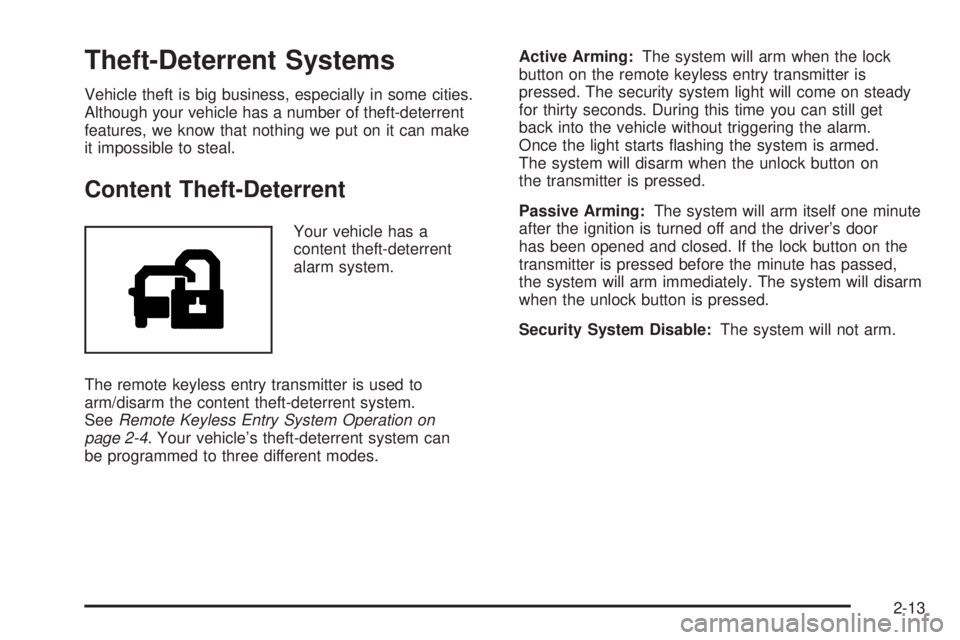2006 PONTIAC TORRENT key
[x] Cancel search: keyPage 77 of 368

There are a couple of ways to manually lock or
unlock your vehicle.
From the outside, use the key in the driver’s door.
From the inside, use the lock control on the door.
Power Door Locks
The power door lock
switches are located
on the driver’s and front
passenger’s doors.
K(Unlock):To unlock the doors, press the
unlock symbol.
Q(Lock):Remove the ignition key and press
the lock symbol to lock all of the doors.
Delayed Locking
A chime will sound three times to indicate a door or
liftgate is open when you try to lock the doors with
the remote keyless entry transmitter or the power
door lock switch. The doors will not lock, and the
theft-deterrent system will not arm until all the doors
are closed and �ve seconds have passed.
The delayed locking feature can be overridden by
pressing the lock button on the remote keyless entry
transmitter, or the door lock switch, a second time.
The doors will lock immediately and when all doors
are closed the theft-deterrent system will arm after
30 seconds.
To get the horn to chirp if a door was open during
the arming process, you must press the lock button
on your transmitter twice after the doors are closed.
2-7
Page 79 of 368

To set the security locks, do the following:
1. Insert the key into the lock above the rear
door security lock label and turn it to the
horizontal position.
2. Close the door.
3. Repeat the steps for the other rear door.
To open a rear door while the security lock is on,
do the following:
1. Unlock the door using the remote keyless entry
transmitter, the front door power lock switch,
or by lifting the rear door manual lock.
2. Open the door from the outside.
To cancel the rear door security lock, do the following:
1. Unlock the door and open it from the outside.
2. Insert the key into the slot next to the rear
door security lock label and turn it to the
vertical position.
3. Repeat the steps for the other lock.Lockout Protection
If you press the power door lock switch when the key
is in the ignition and any door is open, all the doors
will lock and only the driver’s door will unlock. Be sure
to remove the key from the ignition when locking
your vehicle.
If the keyless entry transmitter is used to lock the
doors and the key is in the ignition, a chime will
sound three times. All passenger doors will lock,
but the driver’s door will remain unlocked.
2-9
Page 80 of 368

Liftgate
{CAUTION:
It can be dangerous to drive with the liftgate or
liftglass open because carbon monoxide (CO)
gas can come into your vehicle. You cannot
see or smell CO. It can cause
unconsciousness and even death. If you must
drive with the liftgate open or if electrical
wiring or other cable connections must pass
through the seal between the body and the
liftgate or liftglass:
Make sure all other windows are shut.
Turn the fan on your climate control
system to its highest speed and select the
control setting that will force outside air
into your vehicle. See “Climate Control
System” in the Index.
If you have air outlets on or under the
instrument panel, open them all the way.
SeeEngine Exhaust on page 2-25.To unlock the liftgate, press the unlock button on the
remote keyless entry transmitter twice or use the power
door lock switch.
To lock the liftgate, press the lock button on the remote
keyless entry transmitter or use the power door lock
switch. The liftgate does not have a key lock cylinder.
To open the liftgate, pull up on the handle located in
the center of the liftgate.
When closing the liftgate, use the molded handles to
pull the liftgate down. Push the liftgate closed until
it latches.
2-10
Page 83 of 368

Theft-Deterrent Systems
Vehicle theft is big business, especially in some cities.
Although your vehicle has a number of theft-deterrent
features, we know that nothing we put on it can make
it impossible to steal.
Content Theft-Deterrent
Your vehicle has a
content theft-deterrent
alarm system.
The remote keyless entry transmitter is used to
arm/disarm the content theft-deterrent system.
SeeRemote Keyless Entry System Operation on
page 2-4. Your vehicle’s theft-deterrent system can
be programmed to three different modes.Active Arming:The system will arm when the lock
button on the remote keyless entry transmitter is
pressed. The security system light will come on steady
for thirty seconds. During this time you can still get
back into the vehicle without triggering the alarm.
Once the light starts �ashing the system is armed.
The system will disarm when the unlock button on
the transmitter is pressed.
Passive Arming:The system will arm itself one minute
after the ignition is turned off and the driver’s door
has been opened and closed. If the lock button on the
transmitter is pressed before the minute has passed,
the system will arm immediately. The system will disarm
when the unlock button is pressed.
Security System Disable:The system will not arm.
2-13
Page 84 of 368

Content Theft-Deterrent Personalization
To change the mode that your vehicle is programmed to,
do the following:
1. Turn the ignition to RUN or ACC (Accessory).
2. Press the panic alarm button on the transmitter
slowly four times within �ve seconds.
3. You must complete one of the following within
three seconds to change the mode.
To select the active arming mode, press the
lock button on the transmitter once within
three seconds. A chime will sound two times
to acknowledge that the active arming mode
has been selected.
To select the passive arming mode, press the
lock button on the transmitter twice within
three seconds. A chime will sound three times
to acknowledge that the passive arming
mode has been selected.
To select the security system disable mode,
press the unlock button on the transmitter
once within three seconds. A chime will sound
one time to acknowledge that the security system
disabled mode has been selected.
If you accidentally set off the alarm when entering or
exiting the vehicle, you can shut it off by pressing either
the lock or unlock button once on the remote keyless
entry transmitter. The panic alarm button needs to
be pressed twice to turn off the alarm. There is a
ten second pre-alarm grace period indicated by a
rapid beeping. By pressing the transmitter buttons as
indicated above, you can disarm the system before
the horn begins to sound and the exterior lights begin
to �ash.
If you hear three horn chirps when you press the
unlock button on the transmitter, that means the
vehicle’s alarm was triggered while you were away.
2-14
Page 85 of 368

Passlock®
Your vehicle has the Passlock®theft-deterrent system.
This light will come
on for the theft-deterent
system and is located
on the instrument
panel cluster.
Passlock
®is a passive theft-deterrent system. Passlock®
enables fuel if the ignition lock cylinder is turned with
a valid key. If a correct key is not used or the ignition
lock cylinder is tampered with, fuel is disabled.
If the engine stalls and the security light �ashes, wait
until the light stops �ashing before trying to restart
the engine. Remember to release the key from START
as soon as the engine starts.
If the engine is running and the security light comes
on, you will be able to restart the engine if you turn
the engine off. However, your Passlock
®system is
not working properly and must be serviced by your
dealer. Your vehicle is not protected by Passlock
®at
this time. You may also want to check the fuses.
See your dealer for service.
Starting and Operating
Your Vehicle
New Vehicle Break-In
Notice:Your vehicle does not need an elaborate
break-in. But it will perform better in the long run
if you follow these guidelines:
Do not drive at any one constant speed,
fast or slow, for the �rst 500 miles (805 km).
Do not make full-throttle starts. Avoid
downshifting to brake, or slow, the vehicle.
Avoid making hard stops for the �rst
200 miles (322 km) or so. During this time
your new brake linings are not yet broken
in. Hard stops with new linings can mean
premature wear and earlier replacement.
Follow this breaking-in guideline every time
you get new brake linings.
Do not tow a trailer during break-in.
SeeTowing a Trailer on page 4-38for
the trailer towing capabilities of your
vehicle and more information.
Following break-in, engine speed and load
can be gradually increased.
2-15
Page 86 of 368

Ignition Positions
With the key in the ignition
switch, you can turn it to
four different positions.
A warning tone will sound
if you open the driver’s
door when the key has
not been removed from
the ignition.
Notice:Using a tool to force the key from the
ignition switch could cause damage or break the
key. Use the correct key and turn the key only with
your hand. Make sure the key is in all the way. If
none of this works, then your vehicle needs service.
9(LOCK):You will only be able to remove your key
when the ignition is turned to LOCK.
The ignition switch cannot be turned to LOCK unless
the shift lever is in PARK (P).
ACC (Accessory):This position operates some of your
electrical accessories.
R(RUN):This is the position the switch returns to
after you start your engine and release the switch.
The switch stays in the RUN position when the engine
is running. But even when the engine is not running,
you can use RUN to operate your electrical accessories
and to display some warning and indicator lights.
/(START):This position starts the engine. When the
engine starts, release the key. The ignition switch will
return to RUN for normal driving.
2-16
Page 87 of 368

Retained Accessory Power (RAP)
Your vehicle has a Retained Accessory Power (RAP)
feature which will allow the radio to continue to work
up to 10 minutes after the ignition is turned off.
Your radio will work when the ignition key is in RUN
or ACC. Once the key is turned off, the radio will
continue to work for up to 10 minutes or until any
door is opened.
Starting the Engine
Move your shift lever to PARK (P) or NEUTRAL (N).
Your engine will not start in any other position — that is
a safety feature. To restart when you are already
moving, use NEUTRAL (N) only.
Notice:Shifting into PARK (P) with the vehicle
moving could damage the transaxle. Shift into
PARK (P) only when your vehicle is stopped.
1. With your foot off the accelerator pedal, turn the
ignition key to START. When the engine starts,
let go of the key. The idle speed will go down as
your engine gets warm.Notice:Repeated attempts to start your engine, will
cause your battery to drain much sooner. Excessive
heat can damage your starter motor. Wait about
15 seconds between each try to help avoid draining
your battery or damaging your starter.
2. If it does not start within 10 seconds, rotate the key
back from START to RUN. Holding the key in
START will not cause the vehicle to keep cranking.
Then push the accelerator pedal all the way to
the �oor, while you turn the ignition key to START.
When the engine starts, let go of the key and let
up on the accelerator pedal. Wait about 15 seconds
between each try.
Use the same instructions as stated earlier, when
starting your engine in very cold weather. It is
recommended that you use the engine block heater,
if equipped, to assist in starting your engine in very
cold weather.
Notice:Your engine is designed to work with the
electronics in your vehicle. If you add electrical
parts or accessories, you could change the way the
engine operates. Before adding electrical equipment,
check with your dealer. If you do not, your engine
might not perform properly. Any resulting damage
would not be covered by your vehicle’s warranty.
2-17